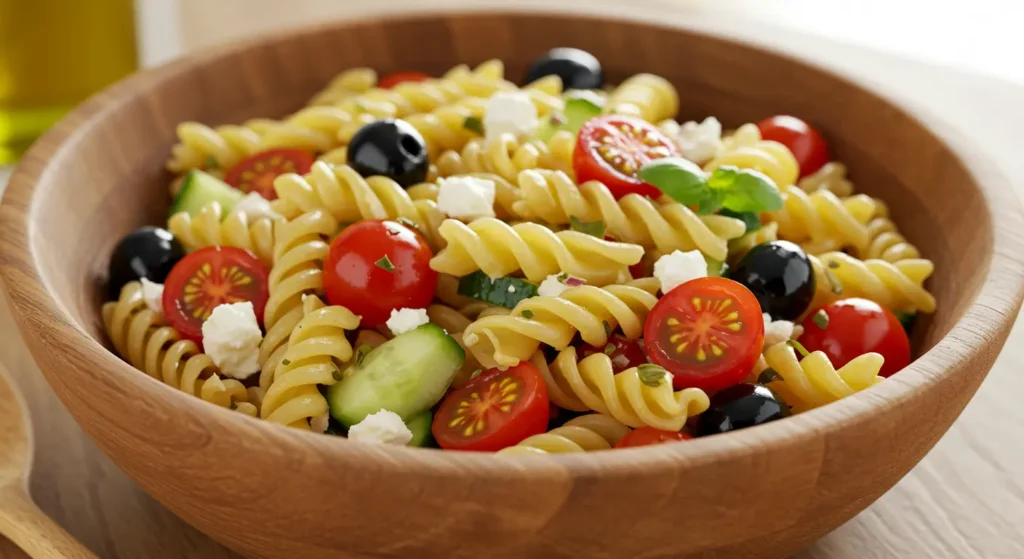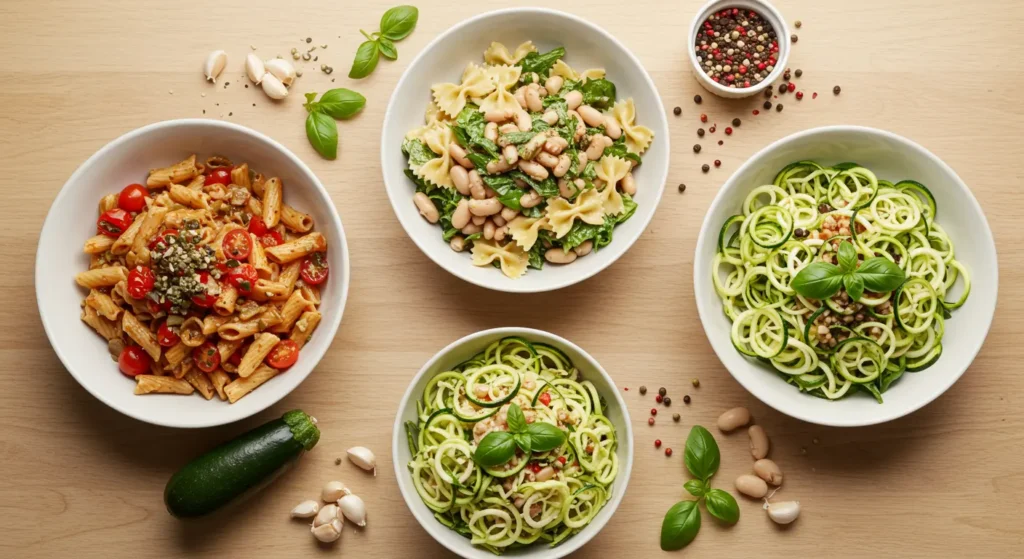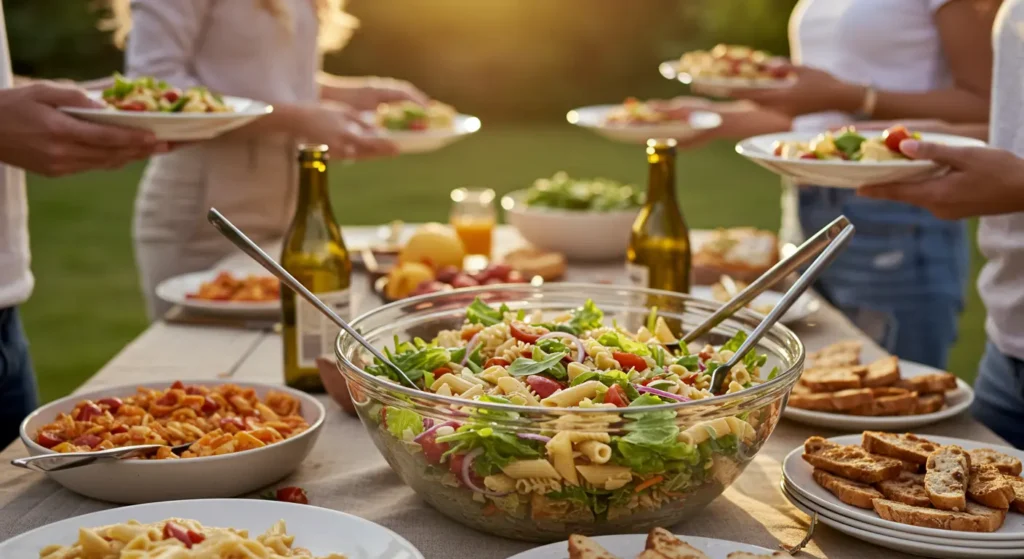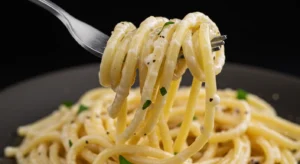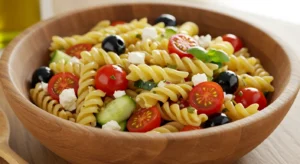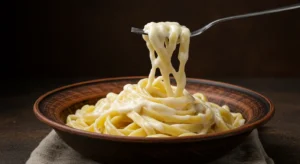Pasta Salad Sides – Why This Recipe Collection?
Growing up in an Italian-American household, pasta salad was a staple at nearly every family gathering. But it wasn’t until I became Chef Greeny that I truly appreciated the versatility of pasta salad as both a main dish and the perfect companion to other foods. My journey with pasta salads began during my culinary school days when I was tasked with creating balanced menus that featured complementary flavors and textures.
What makes pasta salad sides so special is their incredible adaptability. Whether you’re hosting a summer barbecue, planning a picnic in the park, or preparing a weeknight family dinner, pasta salad sides can elevate your meal to new heights. They bring vibrant colors, contrasting textures, and complementary flavors that make the entire dining experience more satisfying.
In this comprehensive guide, I’ll share my favorite pasta salad sides recipes along with expert tips on pairing them with various main dishes. You’ll learn how to create balanced flavor profiles, accommodate dietary restrictions, and impress your guests with professional-level food combinations. By the end of this post, you’ll have all the knowledge needed to transform your pasta salad from a simple side dish to a culinary masterpiece.
Pasta Salad Sides – Ingredients and Preparation
Ingredients List
Classic Mediterranean Pasta Salad Side
- 8 oz rotini pasta (or your preferred short pasta)
- 1 cup cherry tomatoes, halved
- 1 cup cucumber, diced
- ½ cup red onion, thinly sliced
- ½ cup kalamata olives, pitted and halved
- ½ cup feta cheese, crumbled
- ¼ cup fresh parsley, chopped
- 3 tablespoons extra virgin olive oil
- 2 tablespoons red wine vinegar
- 1 clove garlic, minced
- 1 teaspoon dried oregano
- Salt and pepper to taste
Substitution Options:
- Gluten-free pasta for traditional pasta
- Dairy-free feta alternatives for vegans
- Bell peppers instead of cucumber for texture variation
- White beans for added protein
- Avocado oil instead of olive oil for a different flavor profile
Step-by-Step Instructions
Classic Mediterranean Pasta Salad Side:
- Cook the pasta. Bring a large pot of salted water to a boil. Add the pasta and cook according to package instructions until al dente, typically 8-10 minutes. Tip: Add a tablespoon of olive oil to the water to prevent the pasta from sticking together.
- Drain and cool the pasta. Once cooked, drain the pasta in a colander and rinse under cold water to stop the cooking process and cool it down. Allow excess water to drain completely. Tip: Toss the drained pasta with a small amount of olive oil to prevent sticking while it cools.
- Prepare the vegetables. While the pasta cools, chop the tomatoes, cucumber, and red onion. If the red onion flavor is too strong, soak the sliced onions in cold water for 10 minutes, then drain thoroughly. Tip: Keep your vegetable cuts uniform for a more visually appealing dish and consistent flavor in each bite.
- Make the dressing. In a small bowl, whisk together the olive oil, red wine vinegar, minced garlic, dried oregano, salt, and pepper until well combined. Tip: For a smoother emulsion, add a small dollop of Dijon mustard to help bind the oil and vinegar.
- Combine all ingredients. In a large mixing bowl, combine the cooled pasta, prepared vegetables, olives, and feta cheese. Pour the dressing over the ingredients and toss gently until everything is well coated. Tip: Reserve a small amount of feta and herbs for garnishing the top of the salad.
- Garnish and chill. Sprinkle the reserved feta and fresh parsley on top of the salad. Cover and refrigerate for at least 30 minutes before serving to allow the flavors to meld together. Tip: The salad can be made up to 24 hours in advance for even better flavor development.
Notes and Tips
Storage: This pasta salad side dish can be stored in an airtight container in the refrigerator for up to 3 days. The flavors often improve after a day as they continue to meld together.
Serving Suggestions: Serve this pasta salad side alongside grilled chicken, roasted fish, or as part of a Mediterranean mezze platter with hummus and pita bread.
Make-Ahead Instructions: You can prepare all components of this pasta salad side 1-2 days in advance and store them separately. Combine and dress the salad about 30 minutes before serving. If making entirely ahead, reserve some extra dressing to refresh the salad just before serving, as the pasta will absorb some of the dressing while it sits.
Temperature Tip: This pasta salad side is best served cold or at room temperature, making it perfect for outdoor gatherings where food might sit out for a while.
Pasta Salad Sides – Nutritional Information
Nutrition Facts (Per Serving – Approximately 1 cup)
- Calories: 245
- Carbohydrates: 30g
- Protein: 7g
- Total Fat: 12g
- Saturated Fat: 3g
- Unsaturated Fat: 8g
- Trans Fat: 0g
- Fiber: 2g
- Sugar: 3g
- Cholesterol: 15mg
- Sodium: 290mg
This pasta salad side provides a balanced nutritional profile with complex carbohydrates from the pasta, healthy fats from the olive oil and olives, and protein from the cheese. The vegetables add essential vitamins, minerals, and fiber, making this a nutrient-dense accompaniment to your main dish.
Pasta Salad Sides – History and Cultural Significance
Pasta salad as we know it today is primarily an American innovation, though its roots can be traced back to Italian antipasto traditions. Traditional Italian cuisine rarely serves pasta cold, but when Italian immigrants came to America, they adapted their recipes to suit new ingredients and preferences.
The modern pasta salad began gaining popularity in the United States during the 1960s and 1970s, coinciding with the rise of convenience foods and suburban entertaining. The dish became a staple at potlucks, picnics, and backyard barbecues because of its versatility and ability to feed large groups economically.
Different regions have put their unique spin on pasta salad sides:
- Mediterranean-style pasta salads emerged from the growing interest in Mediterranean diets, incorporating ingredients like olives, feta, and olive oil.
- Asian-inspired versions often feature sesame oil, rice vinegar, and vegetables like snow peas and bell peppers.
- Southwestern variations include black beans, corn, and lime-cilantro dressings.
- Italian-American pasta salads typically include salami, provolone, and Italian dressing.
What makes pasta salad sides so culturally significant is their ability to adapt to local ingredients and preferences while maintaining their fundamental appeal as a refreshing, satisfying accompaniment to various main dishes.
Pasta Salad Sides – Creative Variations
Tuscan White Bean Pasta Salad (Vegan Option)
This protein-packed variation swaps the feta cheese for white cannellini beans and adds sun-dried tomatoes for umami depth:
- Use whole wheat pasta for extra fiber and nutrients
- Add 1 cup cannellini beans, rinsed and drained
- Incorporate ¼ cup chopped sun-dried tomatoes
- Mix in 2 tablespoons nutritional yeast for a cheesy flavor without dairy
- Add fresh basil instead of parsley
- Use a lemon-based dressing with garlic and Italian herbs
This variation is excellent alongside grilled vegetables or as a protein-rich main dish for plant-based eaters.
Low-Carb Zucchini “Pasta” Salad
Perfect for those following keto or low-carb diets, this variation replaces traditional pasta with spiralized vegetables:
- Substitute 2 large spiralized zucchinis for the pasta
- Lightly salt the zucchini noodles and let them drain for 15 minutes to remove excess moisture
- Add 1 cup halved cherry tomatoes
- Include ¼ cup toasted pine nuts for crunch
- Mix in ½ cup torn fresh mozzarella
- Dress with pesto instead of vinaigrette
- Finish with a drizzle of balsamic glaze
This refreshing variation pairs wonderfully with grilled steak or salmon for a complete low-carb meal.
Pasta Salad Sides – Frequently Asked Questions
Can I freeze pasta salad sides?
While technically possible, freezing pasta salad is not recommended. The thawing process can make the pasta mushy, and fresh vegetables will lose their crispness. The dressing may also separate upon thawing. Instead, prepare the pasta and store it separately from the dressing and fresh ingredients if you need to make components in advance.
What can I substitute for pasta to make this gluten-free?
There are several excellent substitutions for traditional wheat pasta:
- Gluten-free pasta made from rice, corn, quinoa, or legumes
- Spiralized vegetables like zucchini, carrots, or sweet potatoes
- Quinoa or other gluten-free grains
- Chickpea or lentil pasta for a protein boost
Each option will create a slightly different texture and flavor profile, so consider which would best complement your main dish.
How long does it take to prepare pasta salad sides?
A typical pasta salad side takes about 30 minutes of active preparation time:
- 10 minutes to boil the pasta
- 10 minutes to chop vegetables
- 5 minutes to prepare the dressing
- 5 minutes to assemble everything
Add an additional 30 minutes to several hours for chilling time, depending on your preference. Many pasta salads taste better after the flavors have had time to meld.
What main dishes pair best with pasta salad sides?
Pasta salad sides are incredibly versatile and pair well with numerous main dishes:
- Grilled proteins like chicken, steak, or fish
- Sandwiches and wraps for lunch combinations
- Roasted vegetables for a vegetarian meal
- Burgers and hot dogs at barbecues
- Cured meats and cheeses for an antipasto-style spread
The key is to consider the flavors in your pasta salad and choose a main dish that complements rather than competes with those flavors.
Pasta Salad Sides – Final Thoughts
Pasta salad sides represent the perfect balance of convenience, versatility, and flavor that can transform an ordinary meal into something special. As we’ve explored throughout this guide, these adaptable dishes can be customized to suit any dietary preference, occasion, or culinary theme while providing balanced nutrition and vibrant flavors.
What makes pasta salad sides truly exceptional is their ability to complement without overwhelming. They provide textural contrast to grilled meats, refreshing acidity alongside rich dishes, and satisfying substance with lighter fare. The beauty lies in this perfect harmony—pasta salad sides enhance the entire dining experience while allowing the main dish to shine.
I encourage you to experiment with the recipes and variations shared here. Don’t be afraid to adapt them to your tastes or what’s available in your pantry or garden. Cooking is a creative journey, and pasta salad sides offer endless possibilities for culinary exploration.
Leave a comment with your favorite pasta salad side combination or a creative variation you’ve discovered! I’d love to hear how these recipes have enhanced your meals and gatherings.
For more information about the history of pasta in different cultures, visit Wikipedia’s article on pasta.
